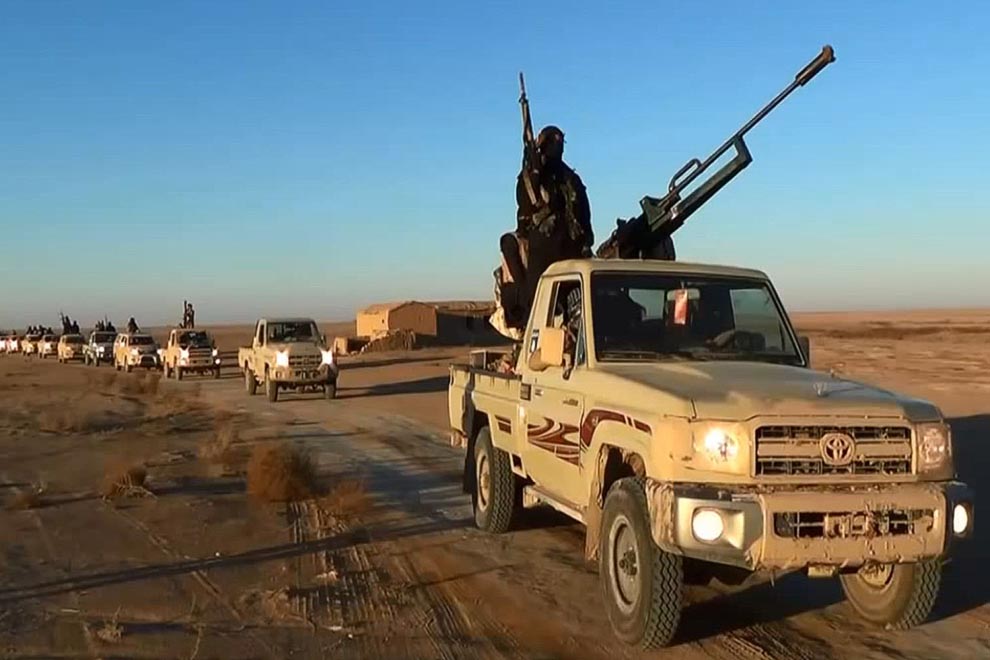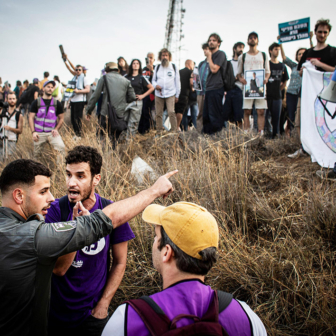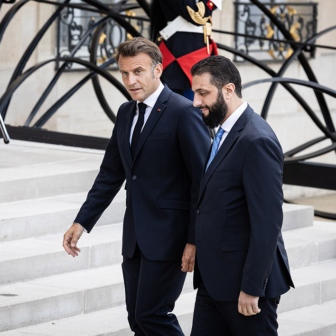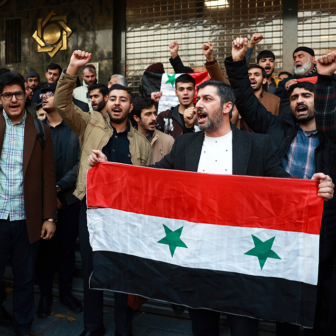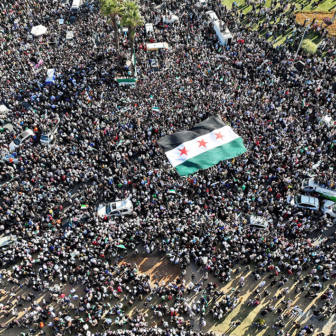The Rise of Islamic State: ISIS and the New Sunni Revolution
By Patrick Cockburn │ Verso │ $21.99
The days when Western news bulletins would broadcast a VHS-recorded diatribe by Osama bin Laden railing against the United States with a nondescript rocky landscape in the background – or more commonly when we would hear a snippet from an audio recording of such a tirade – seem so long ago now, even though the last of them came only months before the al Qaeda leader was killed in a US raid on his compound in Pakistan in 2011.
Although he doesn’t explicitly say so, Patrick Cockburn would undoubtedly argue that bin Laden’s messages seem stale and passé because they are stale and passé. The slickly produced, seamlessly edited and uber-violent videos now coming from ISIS, or “the Islamic State,” reflect the new face and the new methods of Islamic extremism.
ISIS is the acronym for the “Islamic State of Iraq and al-Sham” (“al-Sham” being an old Arabic term for what is now Syria), self-proclaimed as “the Islamic State” to reflect its claim to be the restored and resurrected Caliphate, the sole legitimate theocratic polity succeeding the Prophet Muhammad and governing the world’s Muslims.
ISIS’s claim to be the new Caliphate reflects both its theology and its political ideology. In fact, it would probably argue that the two are inseparable, even indistinguishable, politics being a necessary mechanism – and an opportunity – to spread and consolidate the group’s ideology. As Patrick Cockburn reminds us in The Rise of Islamic State, however, few if any groups have been able to master earthly necessities such as politics and military capability while propounding a religious interpretation as zealous, violent and selectively literalist as ISIS’s. Despite this tension, ISIS seemed to emerge suddenly when it conquered swathes of northwestern Iraq in June last year, and after a raft of military successes now covers an area of Syria and Iraq “larger than Great Britain,” as Cockburn reminds us, “and inhabited by some six million people.”
Several new books on ISIS have hit the bookshops recently: not only Cockburn’s, but also Jessica Stern and J.M. Berger’s ISIS: The State of Terror, Jay Sekulow and others’ Rise of ISIS: A Threat We Can’t Ignore, and several more. It may be tempting to see these as hasty attempts to cash in on one of the great issues du jour. Yet Stern and Berger, for instance, have extensive backgrounds in terrorism and Islamic extremism, and Cockburn himself has a very impressive pedigree on Iraq. Yes, his book was obviously written and published in a hurry, with some silly errors (“July” rather than “June” on page 15) and some messy transliterations here and there, but he writes as a veteran observer of Iraqi politics and the waves of violence that have shredded its social fabric over the past dozen years.
Cockburn has spent close to a quarter of a century in the Middle East, first as a correspondent for the London Financial Times and later reporting for the Independent. He was co-author, with his brother Andrew, of the 1999 book Out of the Ashes: The Resurrection of Saddam Hussein, one of the best works on Iraq in the 1990s, a time when few journalists paid the country much attention. Even during the worst violence of the mid to late 2000s, he was one of the few journalists who, at great personal risk, ventured out into Iraqi streets, shops and homes, reporting with what must have been a depressing frequency on the awful bloodletting of those years.
All this makes Cockburn as good an observer and analyst as any on ISIS, and his book is, overall, a welcome contribution, useful not only for its specifics about ISIS but also for the broader insights it unveils in the process. Cockburn never spares ISIS, but nor does he shy away from identifying actions and policies of the United States and its allies that have handed the organisation opportunities it has so cleverly exploited.
A few of the scrutinies and assessments in The Rise of Islamic State are worth citing and dwelling on to illustrate the book’s style and some of its arguments.
To begin with, Cockburn takes us back a few steps. “The ‘war on terror’ has failed,” he writes, “because it did not target the jihadi movement as a whole and, above all, was not aimed at Saudi Arabia and Pakistan, the two countries that fostered jihadism as a creed and a movement.” This is a central theme of his book: the view that the “war on terror” and its various manifestations have failed or, indeed, have done more harm than good by driving people into the embrace of Islamic extremists. It is a theme he returns to many times.
He recognises that Saudi Arabia and Pakistan were quarantined from the anti-terrorism standards applied to regional states less closely allied to Washington. Yet he tends to underemphasise the domestic settings in which Pakistan’s then-president, Pervéz Musharraf, and the Saudi monarchy operated. In the days following 11 September 2001, Washington gave Musharraf effectively no choice but to cooperate with the US-led war in Afghanistan; in fact, according to Musharraf, the only alternative offered by an American official was that Pakistan would be “bombed back to the stone age.” Yet a swathe of Musharraf’s support base, both among the Pakistani elite and in the population at large, resented the US intervention in Afghanistan, and even more so the fact that Pakistan was dragged into it. Musharraf would probably argue, rightly or wrongly, that in this case he had no choice but to be a political hypocrite.
The Saudi royal family also deserves some of the criticism Cockburn directs at it, but again the realities of Saudi politics get too little attention. The Al Saud do indeed head a wealthy, oil-rich state. But money flowing from the kingdom to extremists is not itemised in the national budget and managed by officials; it is mostly private money, or funds secretly siphoned from state or public sources, sent surreptitiously by sympathetic individuals and groups. Cockburn seems to assume that the Saudis can control every branch of their extensive royal family and all the individuals across their complex political system. No state can.
Cockburn is perhaps on stronger ground in criticising the strategy – or lack of one – of the US war on terror, a set of campaigns conducted in a haphazard fashion and with no central, long-term strategy to guide it (and to avoid such unwanted side effects as the rise of ISIS). For better or worse, though, the fitful US policy is probably mainly the product of a hesitancy in Washington about becoming bogged down fighting wars in the region – much as it has become mired there anyway. To be fair to the Americans, the only recent war they have fought by choice in the region is that in Iraq in 2003. Cockburn is right that ISIS has fed off US back-footedness and indecision, but had things been different there is still no guarantee that such a group would not have emerged. As Cockburn argues, ISIS has its origins in a variety of forces, problems and disastrous misjudgements.
Then there’s the “Arab Spring” and its impact. “The revolutions and popular uprisings of 2011 were as genuine as any in history,” Cockburn writes, “but the way they were perceived, particularly in the West, was often seriously awry. Real revolutions come into being because of an unpredictable and surprising coincidence of people and events with different motives coming together to target a common enemy such as Hosni Mubarak or Bashar al-Assad.”
Whatever the initial optimism, these upheavals have not delivered much substantive change. Only Tunisia has been somewhat successful (despite this week’s museum attack) in making a peaceful transition from autocracy to a more democratic political order. Egypt has struggled to stabilise since Mubarak was removed, while Libya and Yemen teeter on the brink of violent collapse. In Syria, the initial protests morphed, within barely a year, into what is now the nastiest civil war in modern Middle Eastern history.
ISIS is not just the mongrel offspring of al Qaeda and some like-minded clusters, it is also the product of the chaos that came from the Arab Spring; of the violence that accompanied the reactions to it, especially by extant regimes; and of the underlying social and political divisions of Syria and Iraq, which, ominously, exist across much of the region. Cockburn offers a set of insights into what went wrong with the post-2010 Arab uprisings, and these, for a book as brief as this, are quite nuanced. He shows how Western governments and media simplified the uprisings and skewed expectations about their potential; and he also delves into the failings of old authoritarian regimes – their repressiveness, poor economic policies and tolerance or even nurturing of corruption – and how they have fragmented and wedged societal forces and driven some Sunnis in Syria, Iraq and elsewhere into the arms of ISIS and other extremists.
The civil war in Syria, Cockburn writes, “has become like a Middle East version of the Thirty Years’ War in Germany four hundred years ago. Too many players are fighting each other for different reasons for all of them to be satisfied by peace terms and to be willing to lay down their arms at the same time. Some still think they can win and others simply want to avoid defeat.” In Syria, he says, “all sides exaggerate their own strength and imagine that temporary success on the battlefield will open the way to total victory.”
The Syrian conflict is complex even by the standards of the Middle East, where social and other divisions, intervention by regional and other outside players, the use of proxies, and shifts in alliances have often created complicated and opaque dynamics. (The 1975–91 Lebanese civil wars are another obvious example of this level of complexity.) The civil war began as an uprising, not much different in its early months from those that had just overthrown the leaders of Tunisia and Egypt. But, as Cockburn explains, the Syrian regime’s repression of the protests, and the rise of armed opposition gradually turned the conflict into a violent insurgency and then into a civil war shaped by dynamics beyond Syria itself. Sunni–Shia rivalries elsewhere in the region, regional power plays, even to some extent the new cold war–like tensions between the United States and Russia – all these have shaped the conflict.
(The comparison with the Thirty Years’ War may not be as extreme as it sounds. That conflict ultimately killed over a quarter of the population of the German states and claimed perhaps eight million lives all up. The main belligerents took up to a century to rebuild their societies, populations and economies.)
In Iraq, the dynamic is almost as complex. Saddam Hussein’s wars, the 2003 American invasion and subsequent civil conflict reduced Iraq’s GDP to roughly what it was in 1950. Iraq’s violence and the eventual rise of ISIS is a product of Saddam’s brutality, Sunni dominance during his rule, mistakes made by the United States at various points since 1990, sectarian and ethnic problems, and a host of other factors. Iraq’s prime minister between 2006 and 2014, Nouri al-Maliki, also deserves – and receives from Cockburn – a good share of the blame.
Like much of what we see and read about the Middle East these days, Cockburn’s book makes for depressing reading. Sadly, but convincingly, he argues that Iraq and Syria are almost certainly unsalvageable as modern nation-states. Syria as it was has either been physically destroyed or had its social bonds ripped apart. The Sunnis are so embittered towards the Alawites (from which Bashar al-Assad and his father hail), and various other social groups so wronged by Sunni extremists, that communal relations can probably never be restored.
In Iraq, Sunni–Shia tensions, already exacerbated by both sides, were pushed past breaking point by ISIS. Arab–Kurdish tensions were amplified by the Kurds’ opportunistic seizure of Kirkuk in mid 2014 while the Iraqi government and military were distracted by ISIS’s conquest of Mosul.
For the outside world, especially in the West, these events should not be dismissed as just a distant rumble. The Middle East matters to us. We should all be appalled by the beheadings, crucifixions and immolations ISIS conducts and films in order to terrorise us or attract the confused, the marginalised and the foolish. The Middle East is a cradle of civilisation and the origin of many of our religious and social values. It is a region that can shape our economic prospects because of the centrality of oil and gas in the world economy. And it is a region in which the Western world, including Australia, has intervened and, in the process, made plenty of mistakes.
We owe them something, including right now some assistance to counter and defeat the influence of ISIS and other such affronts to universal human values. This must include military support. While Cockburn argues, weakly I believe, that military intervention is bound to fail, I would certainly agree with him on the need for support across humanitarian, economic, governance and other spheres if ISIS’s appeal is to be eroded and the group brought to the point of irrelevance.
Otherwise, as Cockburn reminds us about ISIS, “it may not be long before an organisation renowned for its ruthlessness when seeking revenge sends its suicide bombers to destroy American targets.” Or Australian ones. •
